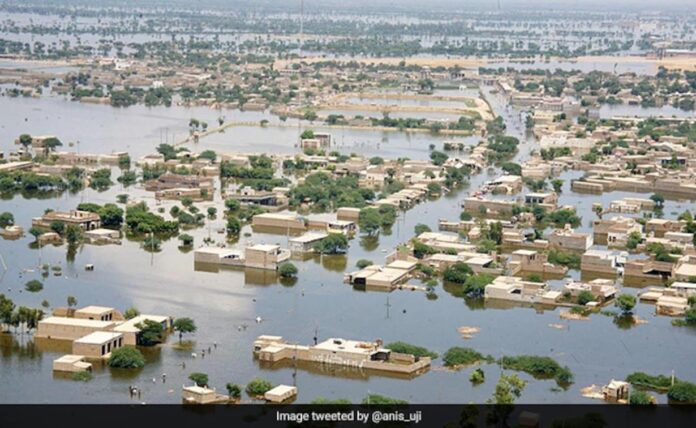Pakistan is not even among the top 100 countries which are subject to maximum rainfall. The country at the hundredth slot receives rain double to Pakistan, according to the data of last 60 years’ average.
But the scale of devastation during floods in Pakistan always remains miserable. When we talk about the extent of destruction we don’t consider the element of mismanagement the whole nation is subject to at the moment. In these times flood is a kind of disaster which doesn’t knock your doors with surprise, and there is always sufficient information available prior to the floods. We were expecting the same kind of calamity, we issued alerts, we ensured announcements, we identified danger zones, we forced evacuations; it means we were fully aware of the severity of expected floods.
But we still failed to save precious lives despite hours before they were swept by the merciless flood waves. We remained unsuccessful in extending a quick response to the victims. Principally if we were aware of the emergence of the flood then it would have been appropriate to have helicopters and evacuation boats ready with searchlights, life jackets and other necessary equipment to execute rapid rescue operations on the entire expected route of the flood.
I think there is absolutely nothing like a ‘quick rescue response’ even in the procedures of the armed forces of Pakistan. We didn’t notice any visible quick response from armed forces during the first two days of the flood. The Army is a disciplined yet extremely capable organization in the Country to handle catastrophe ofn this scale but it can’t respond as long as there is no established mechanism to provide quick and immediate rescue operation.
After two days there was a visible rescue operation by the armed forces which saved several lives. If there had been any mechanism for quick rescue operation in the armed forces we could have probably saved even more lives including those five young friends and an old person in KPK who lost their lives in two different incidents during the flood. Still miseries of people in the South of the country on a usual route after weeks of flood’s initial emergence are making a mockery of the abilities of institutions established for disaster prevention and management.
We need to reflect and determine if we suffered a catastrophe or our mismanagements at every level from the government, administration and masses at large to hinder strategic decisions to protect our motherland. Besides relief and rehabilitation activities we should focus on establishing effective and efficient institutions and processes to avoid any mismanagement in case of catastrophe of this scale in future.
We all feel saddened looking at buildings and hotels washed away by the flood but none of us identified departments and authorities responsible to ensure safe constructions. Why did the relevant departments fail to stop these constructions? Did they issue any warning to these buildings’ owners? If they didn’t then there is a huge question mark on their abilities to ensure safe constructions in vulnerable sites on riverbanks and areas subject to excessive land sliding.
We all shared several videos of vehicles swept away in the flood but no one demanded to penalize people and departments who are responsible for road safety, to put visible signs and water gauges with clear instructions not to enter in the stream of prohibited scale. A number of dams have been breached in Balochistan but there is not even a single voice to condemn the entire process and design of building such vulnerable water reservoirs which eventually aggravated the degree of devastation while consuming exceptional resources for these structures.
The glaring mismanagement is also evident while looking at the tenders of National Disaster Management Authority (NDMA). We all started listening about the unprecedented monsoon season in Pakistan from May onwards this year but the NDMA failed to notice this phenomenon. Detail of tenders from May onwards by the NDMA at their website suggests engagement of the authority in renovation and maintenance of premises and vehicles, tax consultancy, procurement of almirah and jerry cans by the end of July 2022. It was August when the flood had come down from its peak, and the NDMA issued an ‘emergency’ tender for famly tents. Look at the emergency of our disaster management authority that when NGOs such as Al-Khidmat and Edhi have already reached at every depth and breadth of the Country, when relief goods have already reached from Turkey, UAE, China and Qatar, when masses have already extended their support to the victims then our specially established institution issues ‘emergency’ for family tents on August 27.
Now the question is whether these tents will be delivered within stipulated time because the market is already short of tents, and the answer is probably not. The fate of this procurement seems the warehouse and if we don’t, and we pray we don’t, experience this degree of flood in near future the whole purchase will perhaps go in vain, which is a clear example of mismanagement that prevails in our institutions leading to the sufferings of this scale in case of any calamity. I intentionally didn’t mention the name of a country in the hundredth slot in terms of rains because people start talking about the development status while comparing countries. Let’s take the example of Rajasthan which witnessed record rains this monsoon in decades, but the CM appeared in the media and said that we stored enough water, but five reservoirs still have the capacity to store further water.
According to estimates we lose water worth $15 billion every year in addition to destruction repeatedly over the years, but failed to build dams to store water to avoid severe floods, to produce less expensive electricity, anto cultivate more agricultural land to meet food shortages and above all to ensure sustainability and security of Pakistan.
We need to reflect and determine if we suffered a catastrophe or our mismanagements at every level from the government, administration and masses at large to hinder strategic decisions to protect our motherland. Besides relief and rehabilitation activities we should focus on establishing effective and efficient institutions and processes to avoid any mismanagement in case of catastrophe of this scale in future.























